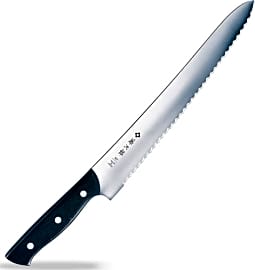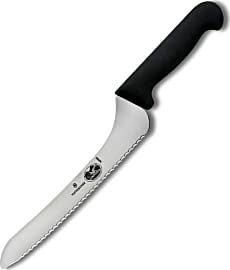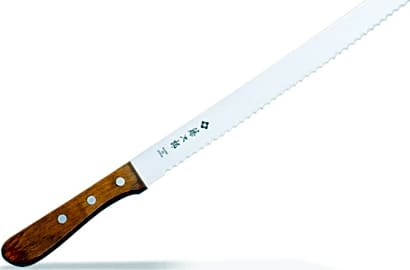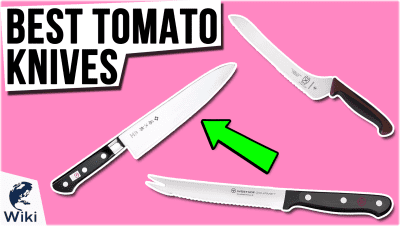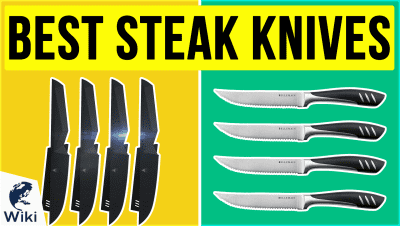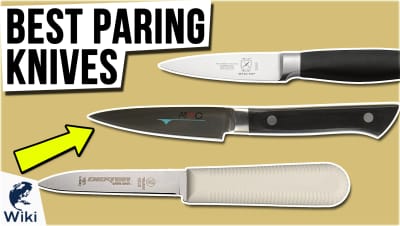The 7 Best Bread Knives

This wiki has been updated 38 times since it was first published in June of 2015. Choosing a bread knife can be a little tricky, because while they're all pretty similar, the subtle differences between them can make a big difference. Most are serrated, but that's where the similarity gets less; some have flat blades and some curved, some have straight handles and some offset, some have edges pointed like saws while others are smooth more wavy, on top of the type of alloy used. When users buy our independently chosen editorial choices, we may earn commissions to help fund the Wiki.
Editor's Notes
April 14, 2021:
Like choosing any other knife, avoid cheaply made, rebranded copies with unknown or unrecognizable brand names, as these can be and are wildly inconsistent, and not likely to satisfy most users. Anything by, for instance, companies like Zelite or Orblue, is generally not considered a worthwhile knife. However, unlike picking something like a chef's knife, there are mostly only subtle difference between bread slicers. Nonetheless, there are still plenty to choose from.
Cooks who want to buy one good knife and keep it for years should consider the Mac Superior SB-105 and Tojiro F-687, both of which excel in just about every area. In terms of excellence, of course, the Güde Alpha is likely at the top of the line, but we don't recommend that most consumers shell out hundreds for a bread knife that isn't great for a ton of other tasks.
Keeping in mind that bread knives are mostly unitaskers, some people aren't enthused about touching these difficult-to-sharpen knives up when they get dull. If that's the case, the Victorinox Fibrox Pro 47550is one option, partly because its offset design makes it easier to power through bread, and partly because its alloy is a bit softer and easier to manage than Japanese knives'. Alternatively, some cooks go so far as to use a serrated bread knife until it's dull, then toss it out - and for those cooks, the Dexter-Russell Basics is absolutely the way to go.
January 14, 2020:
This update involves some reordering of several highly rated, tried-and-true models. The Mercer Culinary Millennia makes its way into the top three selections, thanks to its durable, stain-resistant blade and a handle that’s textured for safety. What’s more, it comes in at a budget-friendly price, especially for the quality you’re getting. Another safety-minded feature is the finger guard, and it also meets the National Sanitation Foundation’s standards for use in food processing and handling. It comes from a Massachusetts-based cutlery manufacturer that’s been around since 1818. It comes highly recommended by America’s Test Kitchen, where it was described as a, “go-to knife for slicing everything from bread to tomatoes to sandwiches.”
The Tojiro F-737 retains its top spot, and it features a high-quality Japanese steel blade with a scalloped edge for clean, even cuts. This makes it great not just for slicing bread, but also for cutting tomatoes and other fruit. This one, too, is attractively priced. It’s also hard to go wrong with the 10-inch-long Victorinox Swiss Army, which boasts excellent mid-sized pointed serrations. Its handle is comfortable for those times you’re cutting vegetables, fruit, or meat for a lengthy session. And if it’s bread you’re dealing with, it won’t smoosh your loaf and keeps the crust intact on each slice.
The Tojiro model and the J.A. Henckels Synergy featured here are both known to slice through tomatoes like butter. For more models specifically designed for this often difficult-to-slice fruit, see our list of best tomato knives.
No matter which knife you’re using, for safety’s sake, be sure to bend the fingers under with the hand that’s holding the food. This helps to keep them out of the way of the slicing knife. Also, be sure to sharpen your knives regularly, as a dull blade requires more force to use, which increases the chance it will slip in your hand. Keep your kids safe by making sure knives are out of their reach.
What's So Special About a Bread Knife?
Overall, bread knives are an important tool to have in any kitchen.
The majority of bread knives have serrated edges on the blade. This is also known as a scalloped edge.
The reason for this is simple: the serration allows the blade to grip better when you take on a hard-crusted exterior while still being able to ease into the soft goodness inside. Most regular kitchen knives will make bread-cutting difficult due to a blade length that's too short and middling sharpness.
The lifespan of the blade is also longer because less force is needed during slicing. A smooth blade can work, too, but only if it’s razor sharp.
Grip matters, as well. You’ll find both harder and softer handles, usually with some type of non-slip feature. They even make handles and special grips for people who have arthritis. Nothing should ever stand in the way of yummy carbs.
Overall, bread knives are an important tool to have in any kitchen. And hey — these long, toothy blades look pretty cool, too.
The Bread Knife: To Gift or Not To Gift
If you’re reading this, chances are that you’re buying a bread knife as a present, perhaps for a wedding shower or that one friend who serves mutilated sandwiches. One thing you’ll want to consider is that knives say a lot about the chef who owns them.
The former will make crusty artisan breads a lot easier to deal with.
Serious cooks often display them in a place of prominence, in a stand on the kitchen counter perhaps, or keep them safely in a carrying case. They will always be at their optimum sharpness. When purchasing a new knife, chefs will think about its use, their budget, and even how well the look of the product will match the overall style of the kitchen. Is it rustic? Modern?
After figuring out a price range and style for your gift, you then have to take into account the length of the blade, its strength and durability, and whether you want a pointed or rounded serrated edge. The former will make crusty artisan breads a lot easier to deal with.
You might even want to weigh the safety concerns. Those thin blades are great for precision, but when they wobble it can be dangerous. Grip, too, has an effect. The chef's hand needs to be comfortable: a comfortable chef is a happy chef, and a happy chef makes better food.
Who's Your Daddy?
It's hard to pinpoint one sole inventor of the bread knife.
If I had to guess, though, it was probably a French artisan hundreds of years ago who kept getting angry at his small knives for totally disfiguring his beautiful, drool-worthy bread. Seriously, the French have bread baking and serving down to a science.
It's hard to pinpoint one sole inventor of the bread knife.
As for when it actually appeared on the market, that credit probably goes to the German Friedrich Dick Company, who exhibited the first bread knife at the 1893 Chicago World's Fair. If you're curious, that company is still around today.
No doubt that at this point, hundreds of frustrated chefs around the world had an "A-ha!" moment and wondered why they hadn't thought of such a useful tool.
The 'Really Useful Serrated Bread Knife Patent' award that we just made up could also go to Syracuse-born Joseph Burns, who paired the idea of the long knife with a wood saw in 1919.
It’s funny that most early bread knives actually had the word "bread" carved or stamped onto the handle. This just goes to show how truly groundbreaking this invention was: the greatest thing before sliced bread.
While styles have changed over the years and the cutting edges have improved, one thing is for sure: we certainly love our bread.


